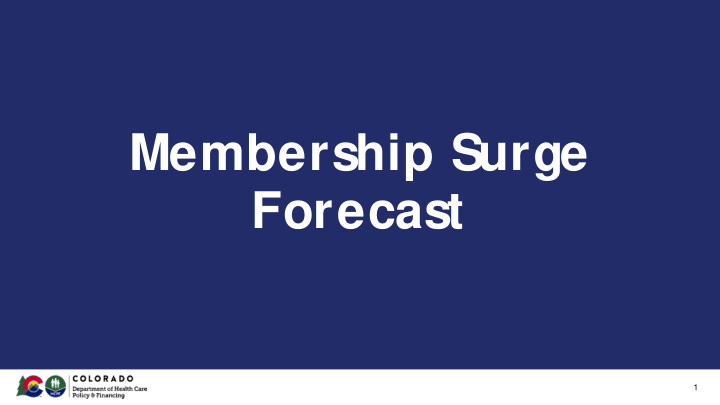



Membership Surge Forecast 1
Colorado’s Unemployment Rate Increase February: 2.5% March: 5.2% April: 11.3% May: 10.2% • Doubled Feb to March and March to April • Highest since state began tracking in 1976 • Prior record was 8.9% during Great Recession in Fall 2010 • Compares to 14.7% nationally - highest since U.S began tracking in 1948 466,645 Coloradans filed initial unemployment claims since mid-March S ource: Colorado Department of Labor and Employment 2
3
Medicaid Category Enrollment Count of Clients enrolled by aid code. Chart shows total enrollments by time periods and the changes in its composition over time. 4
COVID-19 Impact on monthly enrollment By looking at enrollment over the last 18 months, you can see the immediate effects of COVID-19 and continuous enrollment (Maintenance of Effort). 5
Medicaid, CHP+ Membership Surge Forecast • Member surge of 500k+ Coloradans btw April 1 and end of FY2020-21, over 1.3M members covered in Medicaid and CHP+ as of March 2020. • Est disenrollment of ~ 300k members who do not meet eligibility criteria after Maintenance of Enrollment (MOE) • N et membership surge of an est 300k+ covered members 6
2020 Legislative Session Summary & Policy Implementation Updates 7
Budget Impact of COVID-19 8
Legislative Session Summary: Key HCPF Budget Actions Reductions in the Long Bill include: • Reducing HCPF Admin Personal S ervices funding by 5% • Increasing certain member copays to the maximum allowed under federal law • Delaying the implementation of the Inpatient/ Residential S ubstance Use Disorder benefit • Reducing funding for Healthy Communities by 75% • Reducing community provider rates by 1% • Reducing supplemental payments to Denver Health and University Hospital • Reducing PACE rates by 2.37% • Reducing S creening, Brief Intervention, and Referral to Treatment training grants • Reducing S tate support for the All-Payer Claims Database • Reducing funding for the Commission on Family Medicine 9
Other Budget Actions Reductions in other bills include: • Reducing t he annual cap on t he adult dent al benefit from $1500 t o $1000 (HB 20-1361) • Making implement at ion of wraparound services for children and yout h as required by S B 19-195 cont ingent on available appropriat ions. No funding is appropriat ed for FY 2020-21 (HB 20-1384) • Limit ing t he annual rat e increase for skilled nursing facilit ies t o 2% , inst ead of 3% (HB 20-1362) • Using t he increased federal Medicaid financing (HB 20-1385) and Healt hcare Affordabilit y and S ust ainabilit y cash funds t o creat e General Fund relief (HB 20-1386) 10
Additional Bills Passed • HB20-1426 includes mission critical renewal of HCPF’ s overexpenditure and transfer authority • SB20-212: Makes permanent HCPF emergency telemedicine policy changes • SB20-033: Extends the Medicaid Buy-in Program for Working Adults with Disabilities to eligible members 65+ starting in 2022 • HB20-1236: Creates a new “ easy enrollment” program adding the option to be evaluated for eligibility for health coverage to tax filings • HB20-1232: Codifies HCPF policies on coverage of routine costs for clinical trials • HB20-1237: Codifies HCPF policy assigning a child in an out-of-home placement to the same managed care entity that covers the county with j urisdiction over the placement action 28
Next Steps on Telemedicine 12
• 2020-2021 budget cut s were painful. 2021-2022 cut s will be worse. • COVID-19 has shown us t hat providers and The New Coloradans can behave different ly. Normal • This is an opport unit y t o change, t hought fully. • This is an opport unit y for increased collaborat ion and account abilit y. 13
“Driving a New Normal in Healthcare” Opportunity to Work Together • Drive Telemedicine; study its efficiencies and appropriateness • Increase use of eConsults; create best practices • Implement prescriber tool components as they become available • Reduce use of low-value and unnecessary care • Reduce/ repurpose free-standing EDs; discontinue any remaining ED marketing • Frame Alternate Payment Models (APM) to drive value, alignment • Health Equities – disparities in care, gaps in care 14
Learning from COVID – Telemedicine 15
16
Telemedicine Stakeholder Engagement Overview Betsy Holt 17
Goals Information sharing Compliance Equitable input Trust & community 18
• Department approach for studying policy development • Opportunities for providing feedback and input • High-level training and support for telemedicine use and reimbursement 19
• Emphasis on need for compliance with standards and sub-regulatory guidance • S pecific training for specific benefits and services 20
• Ensure that a broad range of voices are heard in the policy development and research process • Ensure that all questions and comments are thoughtfully considered • Ensure that results of that consideration are shared 21
• Leverage the opportunity to demonstrate transparency, build community, and create trusting relationships with providers, members and advocates. 22
High-Level Plan • General information sharing / level-setting webinar, scheduled after July MS B • Leverage opportunities to work with other outreach efforts • S pecific Department training with opportunities to offer feedback • S pecific audience (provider type or regional) engagements with key questions for feedback • S takeholder resource web-page with input form 23
High-Level Plan • Data collection and analysis: Utilization data deep dive External reports Department budget analysis Member survey RAE survey 24
Thank You! 25
Recommend
More recommend